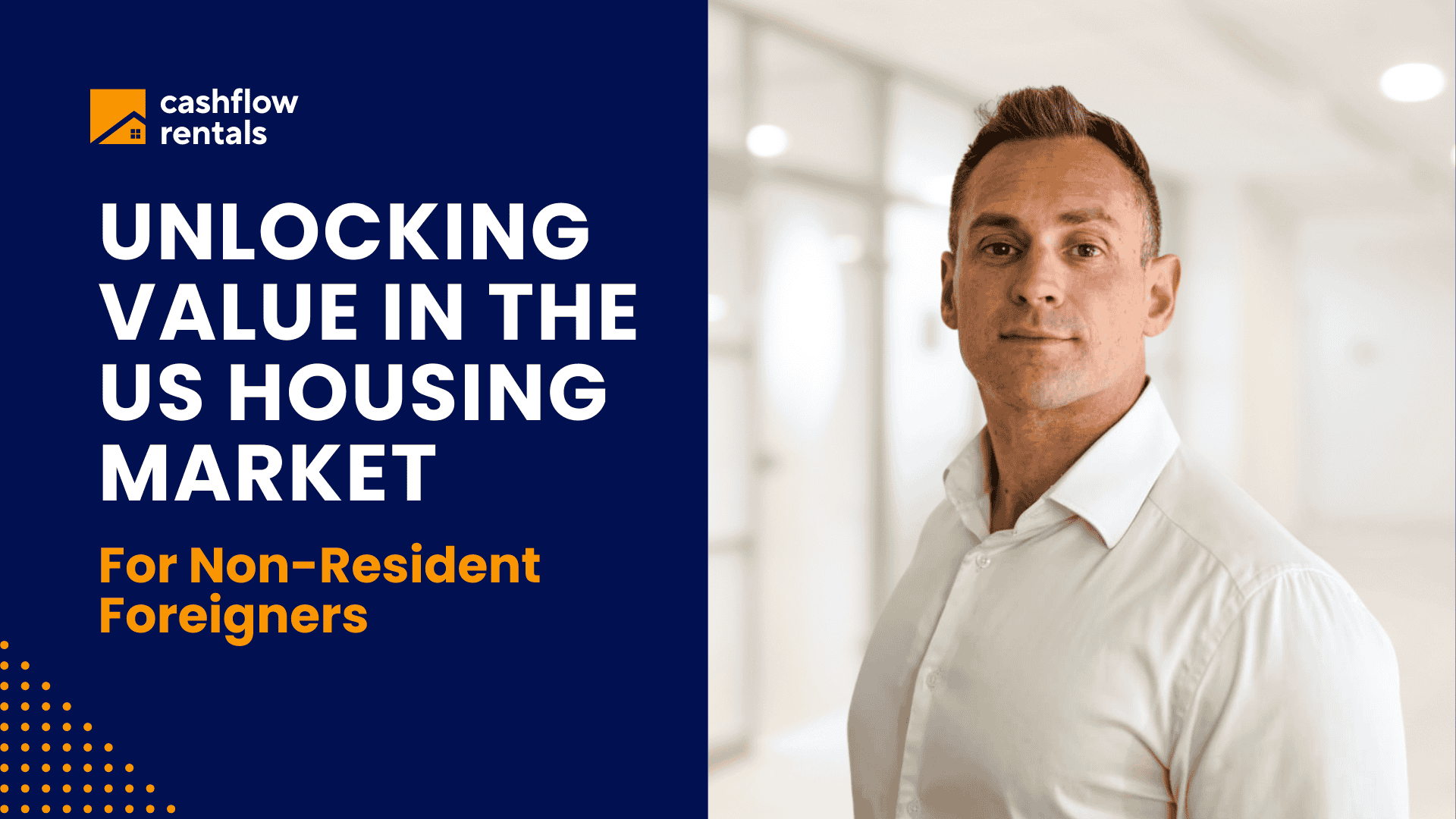Unlocking Value in America’s Uneven Housing Markets
FREE DOWNLOAD: 10 Costly Mistakes Foreigners Make Buying U.S. Real Estate
When I started investing in U.S. real estate as a foreigner in 2016, I quickly realized how important regional nuance is when it comes to housing market data.
After acquiring over 120 investment properties, I’ve developed a hyper-local data-driven approach that cuts through the noise of national housing statistics to find genuine value.
Related: The Market Advantage for Foreign Property Investors in the USA
Why Regional Disparities Matter
Supply and demand dictates the price of all assets, and affordability drives demand for housing more than almost any other factor. This fundamental truth creates predictable patterns across America’s fragmented housing landscape.
Recent forecasts from Zillow confirm what I’ve observed first-hand: Midwest regions with affordable housing like Cleveland and Kansas City will avoid the price declines expected in less affordable markets like Texas, Louisiana, and Florida.
The logic is straightforward. People buy homes where they can afford them.
When affordability deteriorates, demand falls and supply increases, adding downward pressure to houses prices. This creates a natural arbitrage opportunity for investors who understand these regional dynamics.
Related: Hidden Costs of Buying Cheap Investment Property in the USA
Quantifying Risk and Return
Many foreign investors make the mistake of chasing the highest cap rates without understanding the associated risks.
Cap rate isn’t just a measure of return, it’s a measure of risk.
Properties with cap rates exceeding 10% often come with exponentially higher chances of rent delinquencies and property damage. These D-class assets attract D-class tenants with much higher default risks and a plethora of social problems.
Through years of experience, I’ve found the sweet spot lies between 7-10% cap rates.
This range typically allows properties to generate positive cash flow while limiting the operational headaches that erode actual returns. It provides a buffer to ride out market fluctuations while building equity through mortgage paydown regardless of market conditions.
Related: Local Market Expertise is Essential for Overseas Property Investors
Future-Proofing Your Investment
The most successful investments I’ve made focus on “future-proofing” properties through high quality renovations.
Addressing big-ticket infrastructure items upfront like the roof, wiring, plumbing, sewer lines, furnace, and HVAC prevents costly repairs and replcements later. A $10,000 roof replacement or $20,000 sewer line excavation can quickly erase years of positive cash flow.
Quality internal remodels with new kitchens and bathrooms attract better tenants who pay on time and stay longer.
This approach might mean paying more upfront, but it dramatically reduces vacancy rates, delinquencies, repairs, and capital expenditures over time.
Our goal should be to treat a property like an asset, not an ATM. Build up cash reserves for improvements to add value, and/or for additional mortgage payments. Making just one extra mortgage payment per year can reduce the life of your mortgage by 4 or 5 years.
Related: Successful Foreign Investors Use Local Market Data to Identify Opportunities
The Foreign Investor Advantage
As foreign investors buying from a distance, we have an unexpected edge: emotional detachment.
We rely heavily on data, which facilitates more objective decision-making than local investors who might be influenced by personal biases or market narratives.
Tools like CoreLogic and Attom provide accurate, hyperlocal, current, and accessible data that reveal opportunities others might miss by just ‘walking the street’.
Of course, this data-driven approach must be paired with a strong local team that provides physical presence and valuable local market expertise. Real estate is local, and even within a specific neighbourhood there are good streets and bad streets. That local market expertise is like the cherry on the cake when it comes to identifying a good deal vs a bad one.
Related: Why Foreigners Are Buying Investment Properties in the Northeast Midwest and South
Case Study: Cleveland Success
Recently, we helped a client close on an investment property in Cleveland that perfectly illustrates these principles.
Our data analysis showed people moving into the neighborhood, with population rising within a 1-3 mile radius. Vacancy rates were falling, homeownership was increasing, and rental listings were taking 50+ applications within days of hitting the market.
But because local buyers were hesitating – mostly due to interest rate uncertainty – we were able to negotiate a significant seller concession that covered all of our clients closing costs and paid for a mortgage rate buydown of 1%.
This improved monthly cash flow, saved approximately $36,000 in mortgage interest over the loan term, and potentially help to reduce our clients income tax liability.
At the end of the day, market uncertainty means some local buyers try and wait it out, and that creates leverage for investors at the negotiation table.
Related: How to Get a Foreign National Mortgage Without a Visa or SSN
Overcoming Remote Investment Challenges
The biggest challenge foreign investors looking at a property investment in the USA is building the local network needed for proper due diligence and property management.
Successful real estate investment requires coordinating realtors, home inspectors, property managers, attorneys, title companies, insurance agents, contractors, and appraisers. This is difficult to assemble for just one or two properties and even harder to coordinate from overseas.
At Cashflow Rentals, we’ve developed a systematic approach to remote due diligence based on our own experience building our personal portfolio:
Phase 1 combines arms-length property evaluation with physical on-site inspection.
Post-contract, we commission multiple independent inspections and an appraisal to ensure we’re not overpaying or buying hidden problems.
This systematic approach has proven effective across hundreds of transactions for both our own portfolio and our clients.
Related: Population Trends Driving Foreign Investment In USA Property
Capital Requirements and Financing Strategy
I’m cautious about overleveraging. While financing is our best tool for maximizing ROI over the long-term, negative cash flow can quickly derail an investment.
Real estate should pay for itself over time.
I typically recommend a 30% down payment to create an equity buffer and ensure positive cash flow with a comfortable margin.
The client mentioned earlier invested approximately $40,000 cash into the deal that now generates over $300 monthly in positive cash flow after all operating costs and debt service. For most foreign investors, I suggest budgeting around $60,000 (including down payment and closing costs) for a $175,000 property.
That’s based on using a foreign national mortgage like a DSCR loan.
Related: Real Estate Closing Costs in the USA for Foreign Property Investors
Evolution of Strategy
My investment approach in the US property market has evolved significantly over the years.
When I first started, I chased cash flow by buying lower-value homes with high rental yields. In retrospect, this was a mistake.
These deals looked great on spreadsheets but rarely performed as expected. They attracted problematic tenants, caused frequent evictions, and generated substantial turnover costs that destroyed projected cash flow.
These properties also appreciated poorly and proved difficult to sell since homebuyers avoided those neighborhoods.
My most profitable investments have been fully renovated houses in better working-class neighborhoods with quality renovations held for the long term.
This strategy attracts tenants who pay on time and stay longer, limits operational costs, and generates more consistent cash flow. The properties appreciate more reliably, creating a “double whammy” of equity growth with far less management hassle.
Current market analysis shows Midwest properties trading at cap rates 100+ basis points higher than comparable coastal properties, confirming the regional value disparities I’ve been capitalizing on for years.
Related: Cleveland’s Population Shift is Driving Real Estate Investing Opportunities
Current Opportunities
Today, the most compelling investment opportunities exist in Northeast and Midwest markets where housing affordability remains within reach for homebuyers.
Strong job markets in these regions are attracting inward migration, driving demand from both renters and buyers.
The fundamentals that have guided my investment success for years remain unchanged: focus on economic and demographic trends at the regional and neighborhood level rather than broad housing market statistics.
This approach has allowed me to build a portfolio of over 120 properties that consistently outperform the market, and it can work for other foreign investors willing to embrace data-driven objectivity and systematic due diligence.
FREE DOWNLOAD: 10 Costly Mistakes Foreigners Make Buying U.S. Real Estate







![USA Property Investment for Foreign Buyers [2025 Guide]](https://cashflowrentals.net/wp-content/uploads/2025/07/USA-Property-Investment-for-Foreigners-Expert-2025-Guide-500x383.png)



